Adaptations Power Pack (1991) | ||
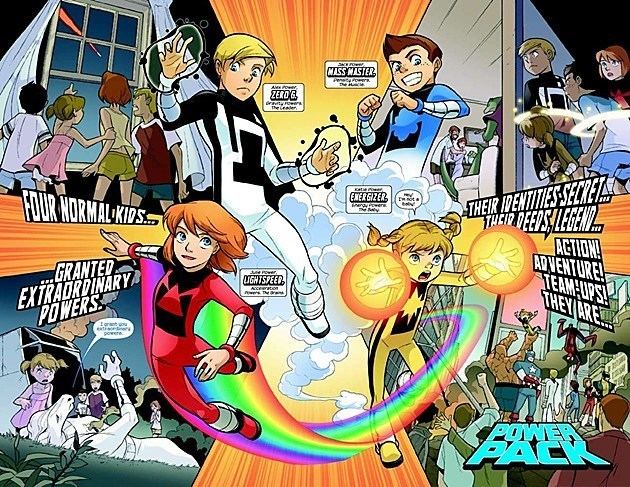 | ||
First appearance Power Pack #1 (May 1984 release; August 1984 cover) Member(s) Alex PowerJulie PowerJack PowerKatie PowerFranklin Richards Similar | ||
Power pack tribute
Power Pack is a fictional team of comic book superheroes consisting of four young siblings who appear in books published by Marvel Comics. They were created by writer Louise Simonson and artist June Brigman and first appeared in their own series in 1984. The series lasted 62 issues. The characters have since appeared in other books.
Contents
- Power pack tribute
- Power pack 1991 tv pilot part 1
- Original series
- Themes of the original series
- 2000 miniseries
- Return of Power Pack
- At the beginning
- End of the series
- Alex New Warriors and the Future Foundation
- Julie ExcelsiorLoners and Avengers Academy
- Members
- Age of Apocalypse
- All ages miniseries
- Mini Marvels
- House of M
- Marvel 2099
- Marvel Zombies
- MC2
- Millennial Visions
- New Mutants
- X Force
- Collected editions
- Television
- Film
- References
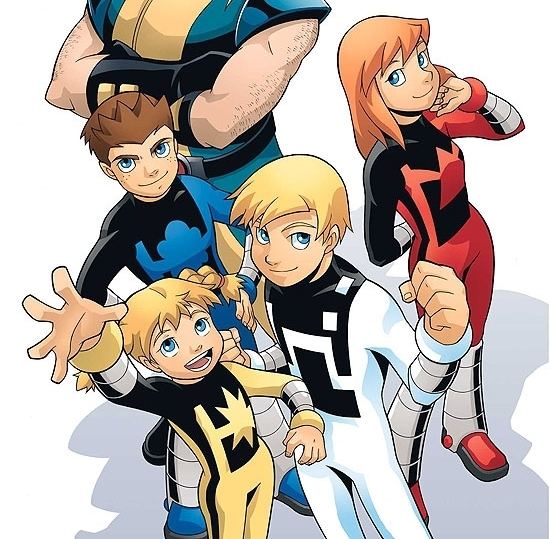
Power Pack is the first team of preteen superheroes in the Marvel Universe and the first in comics to operate without adult supervision. The title retains a cult following and in 2005 was relaunched as a title aimed at younger readers — though this was eventually declared a separate continuity from that of the original series.

Power pack 1991 tv pilot part 1
Original series
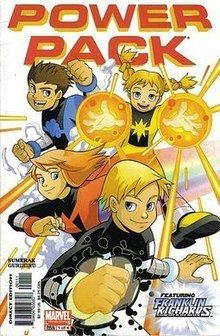
During the early 1980s, Marvel Comics had a policy that all their editors should also do writing. Despite this, Louise Simonson recalled,
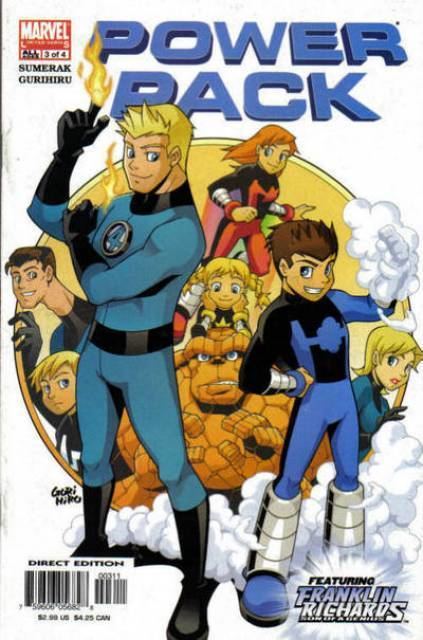
I had resisted Shooter's encouragement to write stuff or do freelance stuff because I thought he had writers whose livelihoods depended on their doing books and it didn't feel fair to take the work away from them. I had a job. But then Shooter hired a whole batch of new editors, and my workload was cut in half. I got bored and I thought I should create something rather than take one of the jobs that were already there, so I proposed the idea for "Power Pack" to Shooter. He eventually loved the idea, and so that was my taste of writing. I found it more challenging than editing, and way more fun, because I had been editing for a long time so I think it had gotten too easy for me.
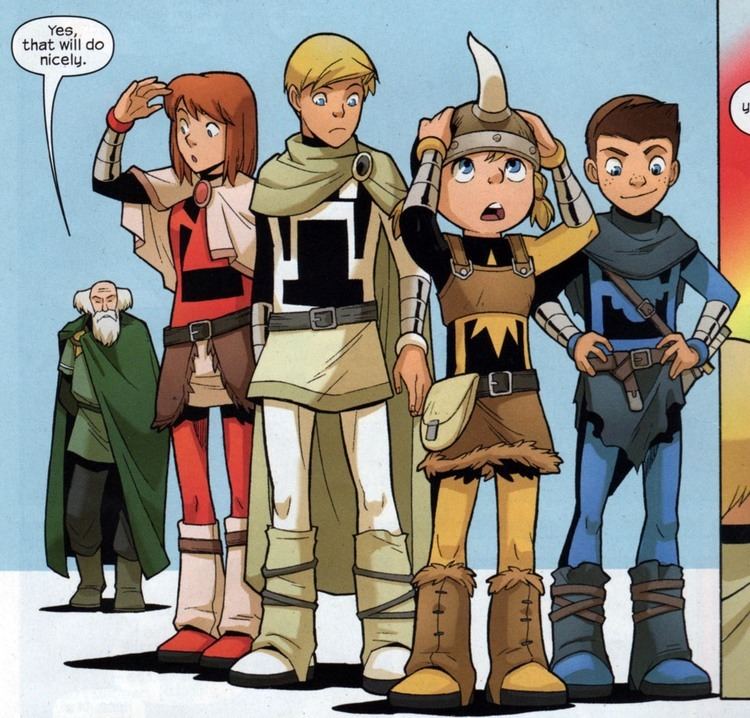
Simonson chose June Brigman as Power Pack's penciler because of her talent for drawing children. The Power Pack series premiered in May 1984 (cover date August 1984) in a double issue inked by Bob Wiacek. The series continued through early 1991, during which time Brigman and Wiacek were replaced by Jon Bogdanove and Hilary Barta as principal artists, and Bogdanove eventually took over as writer.
Dramatic changes were made to the series' art and storylines in 1990, when Michael Higgins and Tom Morgan were brought in to make the comic edgier and more adult beginning with issue #56. The changes were largely reviled by Power Pack readers, and the series was canceled six months later with issue #62. A year and a half after the cancellation of the series, creators Louise Simonson and June Brigman teamed up on the Power Pack Holiday Special, which undid all of the plotlines started by Michael Higgins.
The Power Pack strips were reprinted by Marvel UK beginning around 1986. It was Marvel UK's practice at the time to use a less well-known series as a second strip in a comic devoted to more recognizable characters, and Power Pack became the "back-up strip" in a run of Marvel's licensed Star Wars weekly Return of the Jedi. During this period it was printed partly in black and white and partly in colour, as was the main Star Wars strip. Power Pack subsequently became the back-up strip for the ThunderCats comic, where it remained until its eventual replacement with the Galaxy Rangers series.
Themes of the original series
While the characters of Power Pack were children, the series often dealt with mature issues. Many of the social problems of the eighties found their way into the book's storylines. Among the themes addressed were pollution, drug abuse, runaways, kidnapping, gun violence, bullying, orphanhood, and homelessness.
A major ongoing theme of the series was the relationship between Power Pack and their parents, Jim and Maggie. Unlike superheroes such as Spider-Man or Batman, the Power children were not "conveniently" orphaned and alone; instead, they were part of a loving and supportive family. In spite of this, they decided early in the series to keep their powers and superhero activities completely concealed from their parents. Keeping their powers secret sometimes led the members of Power Pack to deceive their family and friends and to feel guilty about doing so. For instance, in one incident, Julie was forced to allow her school friends to be beaten up by bullies instead of using her powers to defend them. The question of whether or not the powers should be revealed was also an ongoing source of debate among the children. Jack, for instance, found it "cool" to have a secret, while the older and more responsible Julie, who had originally suggested that the powers be concealed from their parents, quickly reversed her opinion and felt that they needed to be told sooner or later. Power Pack readers also argued the matter out in the letter pages.
The writers also emphasized that the Pack had to learn to deal with their powers — and their lethal potential — responsibly. In one early issue, Jack was wracked with remorse when he thought he had killed a man. In a later story arc, Katie dealt with immense guilt, called herself a "monster", and wanted to die after she saw how severely she had injured the Snark prince Jakal.
In 1984, Power Pack was featured with Spider-Man in a special comic designed to fight sexual abuse. The one-shot issue, written by Louise Simonson, was distributed free and reprinted in the comics sections of many major newspapers. Marvel continued the campaign by featuring the characters in print public service announcements. Later the same year, when the Pack was kidnapped during the Snark Wars, the writers used the storyline to address the issue of child abduction and printed photos of missing children in lieu of the comic's regular letters column. In 1989, the team was featured with Cloak and Dagger in a special graphic novel, which addressed the issues of teen homelessness and runaways. Hotline telephone numbers for Covenant House were printed on the back cover for readers seeking help.
The Power Pack letters column, entitled "Pick of the Pack", printed drawings and jokes about the characters submitted by readers, an unusual practice for a Marvel title.
2000 miniseries
In 2000, a four-part Power Pack mini-series was released. In this series, the kids' ages had advanced a few years: Katie was now in the fifth grade (having skipped two grades due to her intelligence), Julie and Jack were in junior high, and Alex was in high school. James and Maggie, the children's parents, had at some time learned about the Power Pack. The Powers now wore masks on their adventures, which, by and large, were restricted to "practice sessions" in the forests around their home in Bainbridge Island, ten miles (16 km) from Seattle. The series once again pitted the Pack against Queen Mauraud and the Snarks in outer space.
Return of Power Pack
Joe Quesada announced in a New Joe Fridays column at Newsarama that Power Pack would be returning to the Marvel Universe in late 2007, after the events of Civil War. However, due to the various delays within their release shipping schedules for Marvel Comics, Power Pack's was delayed. A new Power Pack story was commissioned for the 2007 Marvel Holiday Special, which would have been the first original material featuring the full cast in the standard Marvel Universe since the 2000 mini-series. It was briefly summarized "Power Pack relives holidays past" in official Marvel solicits, but the story was scrapped from the publication at the last minute, when it was decided to prioritize recently canceled title The Loners, which features Julie Power among its cast. A Loners story written by CB Cebulski ran in place of the Power Pack strip, though the official publicity release and solicit information still lists the Power Pack story and description.
Three of the Power siblings, Alex, Jack, and Katie, appear within Fantastic Four #574 as guests celebrating their former teammate Franklin Richards' birthday. During the story, Alex was invited to join Reed Richards' Future Foundation.
During the "All Hope Lies in Doom" story arc within the FF series; the Power Pack were reunited in helping the Future Foundation utilize the Hub to aid in the battles happenning at the Baxter Building.
At the beginning
Alex (age 12), Julie (10), Jack (8), and Katie Power (5) were bright, normal American children living with their parents in a beachfront house in Virginia. Their father, Dr. James Power, was a brilliant physicist who discovered a process to generate energy from antimatter with the assistance of a converter, of which he made a prototype. An error in his formula, which could have caused a chain reaction and destroyed Earth, was discovered by Aelfyre "Whitey" Whitemane, a member of the Kymellian race, who resemble humanoid horses. A similar accident destroyed the Kymellians' home planet.
Whitey tried to stop the experiment by warning the Powers, but was mortally wounded by his enemies, the reptilian Snarks, in the process. The Snarks kidnapped Dr. Power and his wife, Margaret, hoping to obtain the secret of antimatter. Whitey rescued the Power children and told them what was happening. Before dying, he passed his powers to them to complete his mission.
The children, with the help of Whitey's "smartship", a sentient starship called Friday, managed to stop the antimatter test by stealing and destroying the converter and rescued their parents from the Snarks. They decided to continue being superheroes and to hide their powers from their parents. Alex took the codename Gee, Julie became Lightspeed, Jack became Mass Master, and Katie became Energizer. They wore costumes made for them by Friday, which were actually Kymellian spacesuits. The costumes, which were constructed of unstable molecules and stored 'Elsewhere', could materialize and disappear on voice command.
The team, based in New York, attempted to deal with normal "kid problems" such as bullies and loose teeth while battling some of the deadliest villains in the Marvel Universe. The Pack fought the villain Kurse on two occasions during Secret Wars II. They were also heavily involved in the events of the The Fall of the Mutants and Inferno storylines. During the Mutant Massacre, they descended into the sewers and fought Sabretooth.
The Pack's two greatest enemies during the original series were the Snarks and Carmody/The Bogeyman. The Snarks generally attempted to kidnap the Power children and steal their powers. Carmody, James Power's former employer, spotted the Power children when they stole the antimatter converter at the beginning of the series and became obsessed with revenge. At first, he tried to work with government agencies to prove the Powers were mutants. Later, he became a supervillain himself, assuming the identity of the Bogeyman. After being thrown into Limbo by Magik of the New Mutants, he returned in a demonic form and nearly killed the entire Power family before ultimately committing suicide.
Power Pack joined forces with Cloak & Dagger, the X-Men and the New Mutants on numerous occasions.
The team took great pains to conceal their superhuman abilities from their family and "normal" friends. However, during Inferno, when confronted by the demonic Carmody, the children were forced to reveal their powers in order to save their parents. The discovery led Jim and Maggie to have mental breakdowns. They were restored to normal through the combined efforts of Mirage and Gosamyr, who convinced them that the super-powered children were clones created to protect them from Carmody, and that the "real" Power children, who were powerless, had been taken away and guarded by the New Mutants until Carmody was defeated. This explanation placated their parents and, once they were reunited with their "normal" children, their minds healed themselves. The "clones", which had been generated by Mirage, were then removed, making the children's secret safe once again. This "cover-up" proved to be unpopular with readers, and was highly criticized in the comic's letters column.
Another occasional member of the team was Franklin Richards, the son of Mister Fantastic and the Invisible Woman, who went by the name Tattletale while adventuring. James and Margaret Power were introduced to Franklin after the events of the Snark Wars, and befriended Reed and Sue Richards when Franklin was returned to Avengers Mansion. Subsequently, Franklin was often invited to stay with the Power family while his parents were away on missions. Although Franklin was a member of the group, the Fantastic Four had no knowledge of Power Pack until the end of the series; instead, they thought of the Power children simply as "Franklin's friends".
End of the series
Some time later, Alex underwent a transformation into a Kymellian, and Margaret Power began losing her mind. The Power family sought help for Margaret and Alex in various places, beginning with Reed Richards' lab, but their efforts were disrupted by the Red Ghost and his super apes.
The Powers family travelled to the UK to try to find help for Margaret and Alex, but the institute was run over by Nightmare and they encountered Excalibur.
The family decided to abandon New York and fly with Friday to New Kymellia to seek help for Alex and his mother.
However, both Alex and his parents had been replaced by "pseudoplasm" doubles by a renegade Kymellian Technocrat and his ally, the exiled Maraud (called Meraud in this storyline). The real Alex and his parents were being held captive in the Technocrat's hidden satellite orbiting New Kymellia. Eventually, the other Power siblings learned the truth and rescued their family, switching powers several times as needed, and barely escaping from the satellite before it was destroyed by Maraud.
After recovering on New Kymellia, the Power family returned to New York with Friday. Each of the children was back in possession of his or her original power, and their parents remained unaware of the powers or of Power Pack's existence.
Alex, New Warriors and the Future Foundation
The Kymellians had given Alex the ability to absorb the powers of his siblings into himself and thus use them all. With these powers, he joined the New Warriors superhero group under the name Powerpax, later Powerhouse. This caused some friction with Alex's brother and sisters; even their parents noticed the heightened levels of hostility and forced the children to see a psychologist. Alex eventually gave the others' powers back; the four reverted to their original names (except Alex, who named himself Zero-G and Julie, who was now called Starstreak, the name Katie had chosen when she had Julie's powers). Speedball later tried to recruit Alex back into the New Warriors. Alex politely refused, citing the conflicts his membership would cause among his siblings, though Katie offered her services, to Speedball's chagrin.
At some point outside of any published story, their parents discovered that the children had superpowers and were active as superheroes. Why Power Pack's parents could now retain this information without suffering mental trauma and insanity – thanks to telepathic manipulation by Byrel Whitemane that had previously been established as impossible to circumvent – has not been explained.
Following the events of the 2000 mini-series, Julie left the family home in unrevealed circumstances in order to try to become an actress in Los Angeles. Despite Julie's departure from Power Pack, the team defeats Big Wheel. Katie is later seen in costume having beaten several A.I.M. agents unconscious, when Flatman and Doorman offered her membership in the Great Lakes Avengers but she declined, and Power Pack fight Grizzly in New Jersey, a sighting which is used as his alibi against charges that he robbed Madison Square Garden.
During Marvel's Civil War event, Alex's codename Powerhouse was briefly mentioned by Hindsight Lad, an ex-teammate responsible for outing the secret identities of many New Warriors. Alex is one of the 142 registered superheroes who appear on the cover of the comic book Avengers: The Initiative #1.
He is currently a part of Reed Richards' newest project, the Future Foundation, which allows gifted children living within the Baxter Building to map out the outlook for their generation.
Julie, Excelsior/Loners and Avengers Academy
Some time after the events of the 2000 mini-series, Julie Power came to the conclusion that adventuring had deprived her of a normal childhood. She dropped out of high school, left her family, and moved to Los Angeles to become an actress. She joined Excelsior, a support group for "former" teenage superheroes, where she is once again known as Lightspeed. Excelsior's first mission was to return the members of the Runaways to the foster care from which the children had absconded and ended with Excelsior battling Ultron. Though they are not seen on-panel, it is then established that Excelsior spend several months attempting to recapture the child cast of the Runaways, but are constantly thwarted by being ineffectual, getting roped into cleaning up after the Runaways' crimefighting exploits, and on occasion simply by being outsmarted by the Runaways.
The Loners are all registered under the Superhuman Registration Act, but consider themselves retired from super-heroics when they are not battling super-powered menaces or operating in public as superheroes attempting to capture runaway super-powered children. However, Julie later tells the rest of the group that she is not registered. While she is clearly less intelligent and articulate than previously established, Julie reveals in Loners #4 that this is merely an affectation she adopts for the benefit of others – she pretends to be a "dumb blonde" to fit in with Los Angelinos. (It had previously been clearly established that Julie is a redhead, her "blonde" hair the result of using light hues in the production of the comic's art to reflect the brighter climate of the west coast.)
The Loners' support group has moved to New York City, where Julie is presumably seen, though not named, at recent meetings. As with the cast's sudden relocation to Los Angeles from New York between the cancellation of their own series and the beginning of Runaways volume 2, the move is not explained.
Julie was seen among the other young superheroes to arrive on the new campus for the Avengers Academy, where she is attending classes as a teacher assistant, under Quicksilver's tutelage.
Members
The Power siblings have changed powers on more than one occasion and remain the core of the Pack.
Age of Apocalypse
The Power children had been captured and used by Beast in his gruesome experiments which ended with fusing the four siblings together. They were later dissected and kept sealed in containing tubes at his secret laboratory in the Yucatán.
All ages miniseries
A new Power Pack miniseries debuted in 2005. Written by Marc Sumerak and penciled by Gurihiru Studios, it mostly ignored previous Power Pack continuity and was aimed toward young children. Although the initial four-issue series was not released under the Marvel Age imprint because of editorial decisions, it was later reprinted in digest format under the Marvel Age banner. Each of these first four issues focussed on one of the Power children and their respective troubles in balancing the secret of their powers with the demands of their daily lives.
A second Power Pack miniseries by the same creative team, X-Men & Power Pack, debuted in October 2005. The series guest-starred various members and villains from the X-Men comics, including Cyclops, Wolverine, Sabretooth, Beast, Mystique, Nightcrawler, and Mister Sinister and his Marauders. The Circus of Crime also makes an appearance.
A third Power Pack miniseries, titled Avengers & Power Pack: Assemble! debuted in April 2006. This series teamed the Pack with various members of the Avengers: Captain America, Iron Man, Spider-Man, and Spider-Woman. Issues #3 & #4 were a two-part adventure in which the Pack and the Avengers battled Kang the Conqueror, although the latter's plot of conquest which culminates in these two volumes spans the whole miniseries.
A fourth Power Pack miniseries, titled Spider-Man & Power Pack, debuted in November 2006. The series featured Spider-Man and some of his rogue's gallery, such as the Vulture, Sandman, and Venom. The miniseries included two sub-plots: in one, Spider-Man was reduced in age and temporarily joined the Power siblings; the second involved the group teaming up with Spidey to capture Venom symbiote costumes that had been taking control of various women - including Mary-Jane Watson - during part one, and then Katie in part two.
A fifth Power Pack miniseries, Hulk & Power Pack, debuted in March 2007, following the events of the Spider-Man and Power Pack miniseries. The series involved the Hulk and his enemies the Absorbing Man, Abomination, and Zzzax. The miniseries was drawn by David Williams (except for issue #3, which was drawn by Andy Kuhn).
A sixth Power Pack miniseries, Fantastic Four & Power Pack, debuted in July 2007, co-starring the Fantastic Four, who made a previous appearance in issue #3 of the first Power Pack miniseries. Gurihiru Studios returned for the artwork; however, Fred Van Lente replaced Mark Sumerak as writer. The series pitted the Pack against the Fantastic Four's enemies and also featured Franklin Richards, who, as Tattletale, was a member of Power Pack in the regular Marvel Universe.
A seventh Power Pack miniseries, Iron Man & Power Pack, debuted in November 2007, co-starring Iron Man, who had previously appeared in the Avengers & Power Pack: Assemble! miniseries. The series was written by Marc Sumerak and the artwork was by Marcelo Diachara. Opponents include the Puppet Master, the Ghost, Blizzard, Speed Demon and Ultimo. James Rhodes and Pepper Potts also have guest appearances.
An eighth Power Pack miniseries, titled Power Pack: Day One debuted in March 2008. The series, which featured the same creative team as Fantastic Four & Power Pack (Fred Van Lente and Gurihiru), focused on the origins of the team and the incorporation of their new member, Franklin Richards. This series is credited as being "based on" the origin tale from the 1984 series by Louise Simonson and June Brigman, though it is lighter in tone, has a shorter page-count, and changes some plot elements. The series also included scientific back-up information about the physical aspects of the siblings' powers, with artwork by Colleen Coover.
A ninth series, Skrulls vs Power Pack, made its debut in July 2008. The storyline involved the Power Pack encountering the alien Skrulls. This miniseries also introduced the Kymellian Kofi Whitemane to this continuity. The creative team was Fred Van Lente as writer and Cory Hamscher as artist. Gurihiru provided the covers and the colors.
A tenth miniseries, Wolverine and Power Pack, made its debut in November 2008. Wolverine had previously appeared in the X-Men and Power Pack miniseries. The series reunited the original creative team of Marc Sumerak and Gurihiru. Logan and the four children confronted Sauron, faced the Danger Room, and defended the Xavier school against Sentinels, giant robots programmed for anti-mutant genocide. Since the Power siblings are not actually mutants, their intervention was decisive in the outcome of the latter battle. Logan and Power Pack have adventures together in 19th-century New York City and 20th-century Tokyo.
An eleventh Power Pack miniseries began April 2010, with Thor appearing and co-headlining, called Thor And The Warriors Four. The creative team is writer Alex Zalben and artwork once again by Gurihiru. Thor and the Power children confront an evil plot of Loki in order to save the Powers' grandmother. High points include Alex wielding Mjolnir, Beta Ray Bill and the other Asgardians turning into children, a guest appearance by Lockjaw and the Pet Avengers, and Dr. Donald Blake making applesauce. The series also contains a back-up adventure of Hercules telling the story of his Twelve Labors while babysitting the Pack.
Mini Marvels
In a Mini Marvels short, Spider-Man is hired to babysit infant forms of the Power Pack members. Various adventures occur, i.e. he tries to enroll them in "Professor Xavier's Preschool for Mutants".
House of M
Alex and Julie both appear in House of M: Avengers #3, in which they are members of a super-powered gang called the Wolfpack, the House of M's version of the New Warriors.
Marvel 2099
In the alternate timeline of the Marvel 2099 event, Julie, Jack, and Kate form the Power Pack 2099. All of them are adults, whom their powers have since "Slowed their aging to a crawl". Alex is notably missing with no full explanation. They have been hired by Alchemax CEO J. Jonah Jameson to take down Captain America 2099, and Spider-Man 2099. Eventually, it is revealed that the Power Pack are the shape-shifting the Skrulls, who are fully brainwashed into believing they were the Power Pack.
Marvel Zombies
The Power children appear in Marvel Zombies vs. The Army of Darkness #3. All four children have been changed into zombies. They come into conflict with Nextwave, who have not been infected at that point but are ruthlessly dispatched off-panel moments later. Before they killed Nextwave, an explosion violently killed them all, except for Alex Power, who alone appears in Marvel Zombies Halloween along with other zombies attacking Kitty Pryde and her son, Peter.
MC2
Katie appears in issues 2–5 of A-Next, calling herself Kate. During a conversation with American Dream, she indicates that something tragic happened to one of her brothers, but the details of the situation remain unclear.
Millennial Visions
In the "Power Pack: Starting Over" story within Marvel's 2001 Millennial Visions one-shot comic, the team is depicted as a group of adults ranging from 25 (Katie) to 32 (Alex). In this alternate universe, the siblings split up after their parents are killed by anti-mutant activists and lead disparate lives, until they are reunited by Julie to face a new attack from the Snarks.
New Mutants
In a dystopian future ruled by Sunspot, the Power Pack is represented by an elderly Katie, who wields all the powers of the Pack. Katie explains that she has all the powers because her siblings were killed some time ago. She fights for the rights of downtrodden humans and helps the time-lost members of the New Mutants find their way home.
X-Force
A young girl called Francine Power appeared in the pages of X-Force Annual #1, operating under the name Powerpax. She had all of the powers of the various members of Power Pack and wore a costume similar to the one later worn by Alex Power in the pages of New Warriors; this story took place in an alternate future, but, as with all alternate future timelines and out-of-continuity series published by Marvel, the world in which the story is set is also an alternate reality somewhere in the larger Marvel multiverse.
Collected editions
Power Pack Classic volume 4 (ISBN 978-0785162629) was scheduled to be released in March 2013 but was cancelled. It would have contained Power Pack (1984) #27-36 and material from Strange Tales (1987) #13-14.
